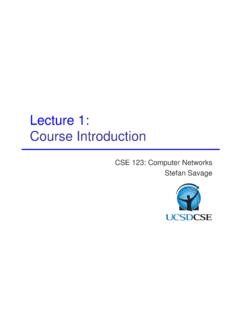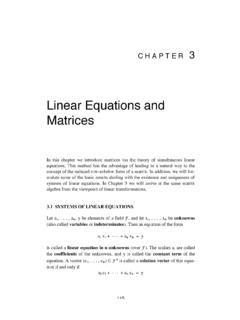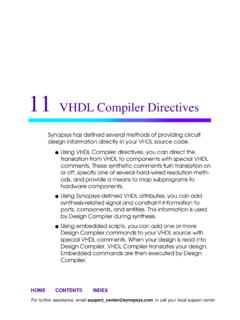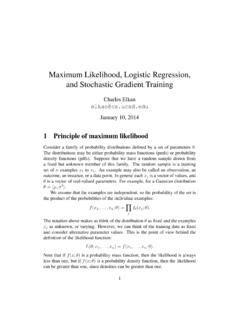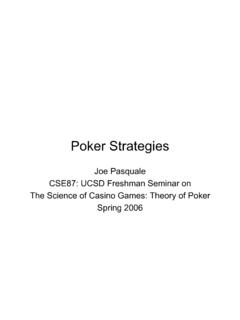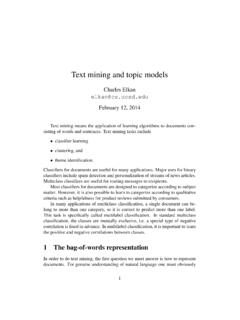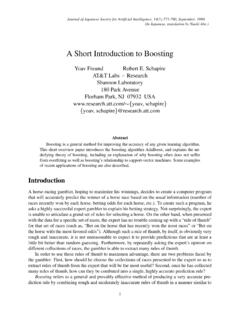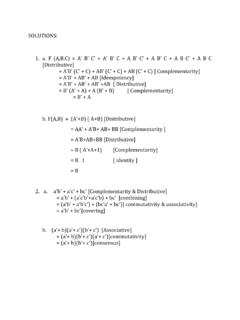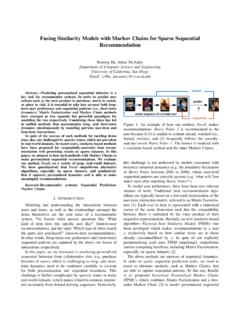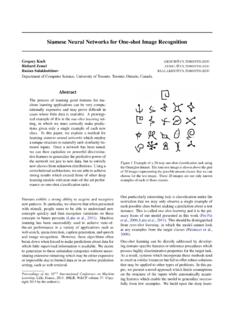Transcription of Lecture 8: Routing I Distance-vector Algorithms
1 CSE 123: Computer NetworksStefan SavageLecture 8: Routing IDistance- vector AlgorithmsThis class New topic: routingHow do I get there from here?Overview Routing overview Intra vs. Inter-domain Routing Distance-vector Routing protocols3 Forwarding Move packet from input link to the appropriate output link Purely local computation Must go be very fast (executed for everypacket) Routing Make sure that the next hop actually leads to the destination Global decisions; distributed computation and communication Can go slower (only important when topology changes)Router Tasks Source Routing Complete path listed in packet Virtual circuits Set up path out-of-band and store path identifier in routers Local path identifier in packet Destination-based forwarding Router looks up address in forwarding table Forwarding table contains (address, next-hop) tuplesForwarding Options Routing Host computes path Must know global topology and detect failures Packet contains complete ordered path information node A then D then X then Requires variable length path header Forwarding Router looks up next hop in packet header, strips it off and forwards remaining packet Very quick forwarding, no lookup required In practice ad hoc networks (DSR), some HPC networks (Myrinet), and for debugging on the Internet (LSR,SSR)
2 Source Routing Routing Hosts sets up path out-of-band, requires connection setup Write (input id, output id, next hop) into each router on path Flexible (one path per flow) Forwarding Send packet with path id Router looks up input, swaps for output, forwards on next hop Repeat until reach destination Table lookup for forwarding (faster than IP lookup?) In practice ATM: fixed VC identifiers and separate signaling code MPLS: ATM meets the IP world (why? traffic engineering)Virtual Circuits Routing All addresses are globally known No connection setup Host sends packet with destination address in header No path state; only routers need to worry about failure Distributed Routing protocol used to Routing tables Forwarding Router looks up destination in table Must keep state proportional to destinations rather than connections Lookup address, send packet to next-hop link All packets follow same path to destination In Practice: IP routingDestination-based Forwarding The Routing table at A, lists at a minimum the next hops for the different destinationsDGAFEBCDestNext HopBBCCDCEEFFGFR outing Tables Essentially a graph theory problem network is a directed graph; routers are vertices Find best path between every pair of vertices In the simplest case, best path is the shortest pathDGAFEBC=router=linkX111111111 =cost10 Routing on a Graph How to choose best path?
3 Defining best can be slippery How to scale to millions of users? Minimize control messages and Routing table size How to adapt to failures or changes? Node and link failures, plus message lossRouting Challenges Routing within a network /organization A single administrative domain The administrator can set edge costs Overall goals Provide intra- network connectivity Adapt quickly to failures or topology changes Optimize use of network resources Non-goals Extreme scalability Lying, and/or disagreements about edge costs We ll deal with these when we talk about inter-domainrouting12 Intra-domain Routing Static Type in the right answers and hope they are always true ..So far distance vector Tell your neighbors when you know about everyone Today s Lecture ! Link state Tell everyone what you know about your neighbors Next ApproachesDistance vector algorithm Base assumption Each router knows its own address and the cost to reach each of its directly connected neighbors Bellman-Ford algorithm Distributed route computation using only neighbor s info Mitigating loops Split horizon and posion reverse14 Define distances at each node X dx(y) = cost of least-cost pathfrom Xto Y Update distances based on neighbors dx(y) = min {c(x,v) + dv(y)} over all neighbors V3221141453uvwxyzstdu(z) = min{c(u,v) + dv(z), c(u,w) + dw(z)}Bellman-Ford AlgorithmIterative, asynchronous: each local iteration caused by: Local link cost change distance vector update message from neighborDistributed.
4 Each node notifies neighbors onlywhen its DV changes Neighbors then notify their neighbors if necessarywaitfor (change in local link cost or message from neighbor)recomputeestimatesif distance to any destination has changed, notifyneighbors Each node: distance vector Algorithm16 c(x,v)=cost for direct link from xto v Node x maintains costs of direct links c(x,v) Dx(y)= estimate of least cost from xto y Node xmaintains distance vector Dx= [Dx(y): y N ] Node xmaintains its neighbors distance vectors For each neighbor v, xmaintains Dv= [Dv(y): y N ] Each node vperiodically sends Dvto its neighbors And neighbors update their own distance vectors Dx(y) minv{c(x,v) + Dv(y)}for each node y NStep-by-Step17178221 AEBCDInfo at nodeDistance to NodeABCDEA07 1B70 1 8C 102 D 202E18 20 Example: Initial State18178221 AEBCDInfo at nodeDistance to NodeABCDEA07 1B70 1 8C 102 D 202E18420I m 2 from C, 0 from D and 2 from ED is 2 away, 2+2< , so best path to C is 4 Dsends vector to E19178221 AEBCDInfo at nodeDistance to NodeABCDEA078 1B70 1 8C 102 D 202E18420I m 7 from A, 0 from B, 1 from C & 8 from EB is 7 away, 1+7< so best path to C is 8 Bsends vector to A20I m 1 from A, 8 from B, 4 from C, 2 from D & 0 from E178221 AEBCDInfo at nodeDistance to NodeABCDEA07531B70 1 8C 102 D 202E18420E is 1 away, 4+1<8 so C is 5 away, 1+2< so D is 3 awayEsends vector to A21178221 AEBCDInfo at nodeDistance to Convergence22178221 AEBCDDestNext hopAECA796C12121D10103E885 Node B s distance vectors23178221 AEBCDInfo at nodeDistance to NodeABCDEA0781012B70135C81024D103202E125 420 A marks distance to E as , and tells B E marks distance to A as , and tells B and D B and D recompute routes and tell C.
5 E and E until convergeHandling Link Failure241 ACB2321 ACB34 Update 31 ACBU pdate to CCounting to Infinity25 Updates don t contain enough information Can t totally order bad news above good news Baccepts A s path to Cthat is implicitlythrough B! Aside: this also causes delays in convergence even when it doesn t count to infinityWhy so High?26 Hold downs As metric increases, delay propagating information Limitation: Delays convergence Loop avoidance Full path information in route advertisement Explicit queries for loops Split horizon Never advertise a destination through its next hop Adoesn t advertise Cto B Poison reverse: Send negative information when advertising a destination through its next hop Aadvertises Cto Bwith a metric of Limitation: Only works for loop s of size 2 Mitigation Strategies27If Zroutes through Yto get to X: Ztells Yits (Z s) distance to Xis infinite (so Ywon t route to Xvia Z)XZ1450Y60 Poison Reverse Example28 Split Horizon Limitations A tells B & C that D is unreachable Bcomputes new route through C Tells Cthat Dis unreachable(poison reverse) Tells Ait has path of cost 3(split horizon doesn t apply) Acomputes new route through B Atells Cthat Dis now reachable 291 ACBD111 RIP.
6 Routing Information Protocol DV protocol with hop count as metric Infinity value is 16 hops; limits network size Includes split horizon with poison reverse Routers send vectors every 30 seconds With triggered updates for link failures Time-out in 180 seconds to detect failures Rarely used today EIGRP: proprietary Cisco protocol Ensures loop-freedom (DUAL algorithm ) Only communicates changes (no regular broadcast) Combine multiple metrics into a single metric (BW, delay, reliability, load)In practice Routing is a distributed algorithm React to changes in the topology Compute the paths through the network distance vector shortest-path Routing Each node sends list of its shortest distance to each destination to its neighbors Neighbors update their lists; iterate Weak at adapting to changes out of the box Problems include loops and count to infinitySummary31 Next time Link state Routing Turn in
